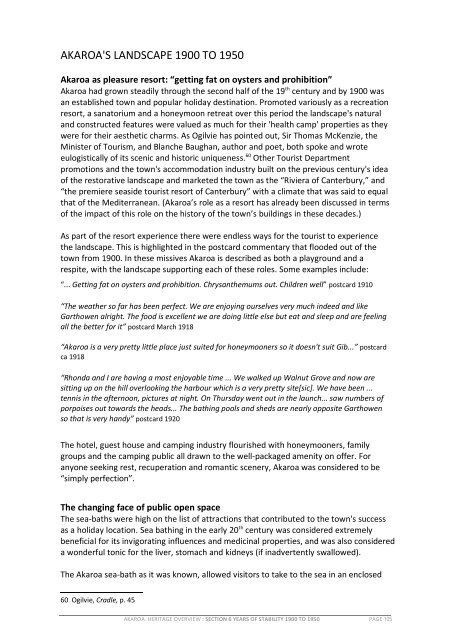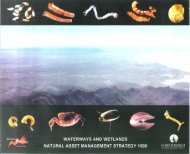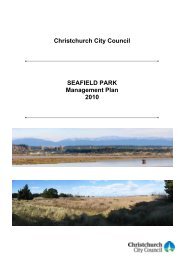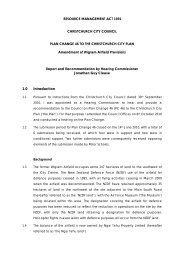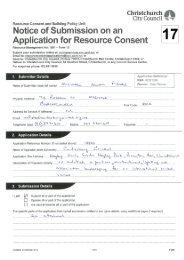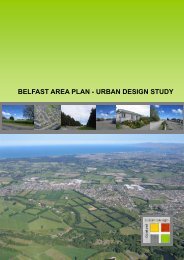Akaroa Historical Overview - Christchurch City Council
Akaroa Historical Overview - Christchurch City Council
Akaroa Historical Overview - Christchurch City Council
You also want an ePaper? Increase the reach of your titles
YUMPU automatically turns print PDFs into web optimized ePapers that Google loves.
AKAROA'S LANDSCAPE 1900 TO 1950<br />
<strong>Akaroa</strong> as pleasure resort: “getting fat on oysters and prohibition”<br />
<strong>Akaroa</strong> had grown steadily through the second half of the 19 th century and by 1900 was<br />
an established town and popular holiday destination. Promoted variously as a recreation<br />
resort, a sanatorium and a honeymoon retreat over this period the landscape's natural<br />
and constructed features were valued as much for their 'health camp' properties as they<br />
were for their aesthetic charms. As Ogilvie has pointed out, Sir Thomas McKenzie, the<br />
Minister of Tourism, and Blanche Baughan, author and poet, both spoke and wrote<br />
eulogistically of its scenic and historic uniqueness. 60 Other Tourist Department<br />
promotions and the town's accommodation industry built on the previous century's idea<br />
of the restorative landscape and marketed the town as the “Riviera of Canterbury,” and<br />
“the premiere seaside tourist resort of Canterbury” with a climate that was said to equal<br />
that of the Mediterranean. (<strong>Akaroa</strong>’s role as a resort has already been discussed in terms<br />
of the impact of this role on the history of the town’s buildings in these decades.)<br />
As part of the resort experience there were endless ways for the tourist to experience<br />
the landscape. This is highlighted in the postcard commentary that flooded out of the<br />
town from 1900. In these missives <strong>Akaroa</strong> is described as both a playground and a<br />
respite, with the landscape supporting each of these roles. Some examples include:<br />
“... Getting fat on oysters and prohibition. Chrysanthemums out. Children well” postcard 1910<br />
“The weather so far has been perfect. We are enjoying ourselves very much indeed and like<br />
Garthowen alright. The food is excellent we are doing little else but eat and sleep and are feeling<br />
all the better for it” postcard March 1918<br />
“<strong>Akaroa</strong> is a very pretty little place just suited for honeymooners so it doesn't suit Gib...” postcard<br />
ca 1918<br />
“Rhonda and I are having a most enjoyable time ... We walked up Walnut Grove and now are<br />
sitting up on the hill overlooking the harbour which is a very pretty site[sic]. We have been ...<br />
tennis in the afternoon, pictures at night. On Thursday went out in the launch... saw numbers of<br />
porpoises out towards the heads... The bathing pools and sheds are nearly opposite Garthowen<br />
so that is very handy” postcard 1920<br />
The hotel, guest house and camping industry flourished with honeymooners, family<br />
groups and the camping public all drawn to the well-packaged amenity on offer. For<br />
anyone seeking rest, recuperation and romantic scenery, <strong>Akaroa</strong> was considered to be<br />
“simply perfection”.<br />
The changing face of public open space<br />
The sea-baths were high on the list of attractions that contributed to the town's success<br />
as a holiday location. Sea bathing in the early 20 th century was considered extremely<br />
beneficial for its invigorating influences and medicinal properties, and was also considered<br />
a wonderful tonic for the liver, stomach and kidneys (if inadvertently swallowed).<br />
The <strong>Akaroa</strong> sea-bath as it was known, allowed visitors to take to the sea in an enclosed<br />
60 Ogilvie, Cradle, p. 45<br />
AKAROA HERITAGE OVERVIEW : SECTION 6 YEARS OF STABILITY 1900 TO 1950 PAGE 105


